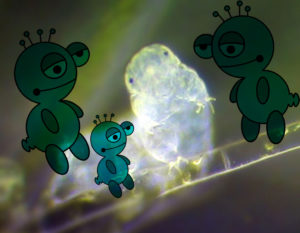Source:::: http://news.meta.com/2015/11/23/waterbear/
PNAS: The tardigrade (water bear), the only animal that can survive in the vacuum of space, has the most foreign DNA of any animal.
The tardigrade, also known as the water bear, is renowned for many reasons. The nearly indestructible micro-organism is known to have the capacity to survive extreme temperatures (-272C to 151C), and is the only animal able to survive in the vacuum of space.
Today, with the publication of its genome in PNAS, the humble water bear can add another item to its exhaustive list of superlatives. Sequencing of the genome, performed by a team of researchers at the University of North Carolina at Chapel Hill, has revealed that a massive portion of the tiny organism’s genome is of foreign origin. Indeed, nearly 17.5% of the water bear’s genome is comprised of foreign DNA, translating to a genetic complement of approximately 6,000 genes. These genes are primarily of bacterial origin, though genes from fungi and plants have also been identified.
Horizontal gene transfer, defined as the shifting of genetic material materially (thus horizontally) between organisms is widespread in the microscopic world. In humans, however, the process does occur, but in a limited fashion, and via transposons and viruses. Other microscopic animals are also known to have large complements of foreign genes.
Until today, the tiny rotifer was believed to have the greatest complement of foreign DNA of any microscopic organism. Surprisingly, that genetic complement constitutes only half of what has been identified in the newly published tardigrade genome.
The authors of the newly published work have proposed a method by which this extremely extensive gene transfer may have occurred. Tardigrades have long been known to undergo, and survive, the process of desiccation (extreme drying out). The authors therefore postulated that during this drying out process and the subsequent rehydration, the tardigrade’s genome may have undergone significant sheering and breakage, resulting in a general loss of integrity and leakiness experienced by the water bear’s nucleus. In turn, this compromised nuclear integrity may have enabled foreign genetic material to readily integrate the genome, in much the same way as scientists perform gene transfer through the process of electroporation.
For now, the tardigrade has a dual claim to fame, being the only known animal to survive the vacuum of space, and being the animal with the largest genetic complement. Only with the study of other micro-organisms will we be able to validate if the humble tardigrade maintains its two, current, great claims to fame.
Source: Thomas C. Boothby, Jennifer R. Tenlen, Frank W. Smith, Jeremy R. Wang, Kiera A. Patanella, Erin Osborne Nishimura, Sophia C. Tintori, Qing Li, Corbin D. Jones, Mark Yandell, David N. Messina, Jarret Glasscock, and Bob Goldstein Evidence for extensive horizontal gene transfer from the draft genome of a tardigrade PNAS 2015 ; published ahead of print November 23, 2015, doi:10.1073/pnas.1510461112


